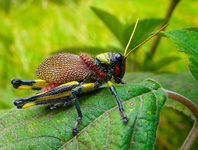Abstract
Liladownsia fraile gen. nov. sp. nov. Fontana, Mariño-Pérez, Woller & Song (Lila Downs’ friar grasshopper) of the tribe Dactylotini (Orthoptera: Acrididae: Melanoplinae) is described from the pine-oak forest of the Sierra Madre del Sur Mountain Range in Oaxaca, Mexico. Taxonomic placement of this new genus is justified based on morphological characters as well as a molecular phylogeny. Information about the probable host plant, phenology, and known localities is also presented. We also present an updated molecular phylogeny of Melanoplinae, which includes representatives of five of the seven recognized tribes. The monophyly of the subfamily and the included tribes is tested and we find Dactylotini to be paraphyletic because of the placement of Hesperotettix Scudder, 1876. We also recover strong close relationships between the new genus and Perixerus Gerstaecker, 1873 and Dactylotum Charpentier, 1845.

